
| WWT Shows | CLICK TO: Join and Support Internet Horology Club 185™ | IHC185™ Forums |

|
• Check Out Our... • • TWO Book Offer! • |
Welcome Aboard IHC185™  Internet Horology Club 185
Internet Horology Club 185  IHC185™ Discussion Site Main Page
IHC185™ Discussion Site Main Page  Open to the World RESEARCH FORUMS
Open to the World RESEARCH FORUMS  Illinois Watch Company Research Forum
Illinois Watch Company Research Forum  Illinois Dial + Movement combinations
Illinois Dial + Movement combinations
 Internet Horology Club 185
Internet Horology Club 185  IHC185™ Discussion Site Main Page
IHC185™ Discussion Site Main Page  Open to the World RESEARCH FORUMS
Open to the World RESEARCH FORUMS  Illinois Watch Company Research Forum
Illinois Watch Company Research Forum  Illinois Dial + Movement combinations
Illinois Dial + Movement combinationsGo  | New Topic  | Find-Or-Search  | Notify  | Tools  | Reply to Post  |  |
| IHC Member 1736 |
1918 Illinois grade 167 correct dial - Illinois Blue Book states: White glass enamel or silvered metal dial 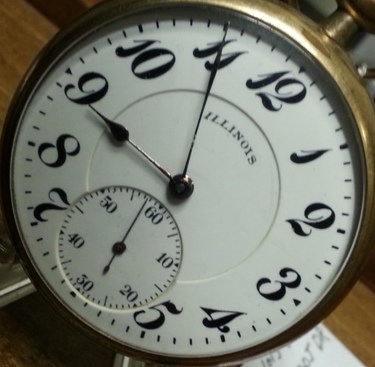 | ||
| IHC Member 1736 |
1918 Illinois grade 167 movement serial number 5558134 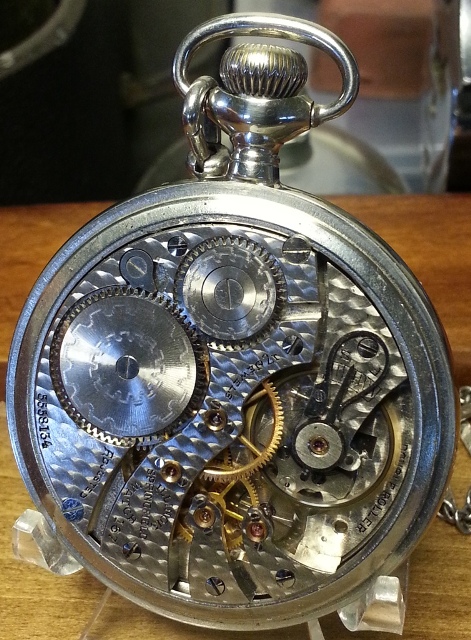 | |||
| IHC Member 1736 |
1894 Illinois 18S Grade 65S PL correct dial - Source states: Double Sunk hard or glass enamel dial marked "Illinois Watch Co" 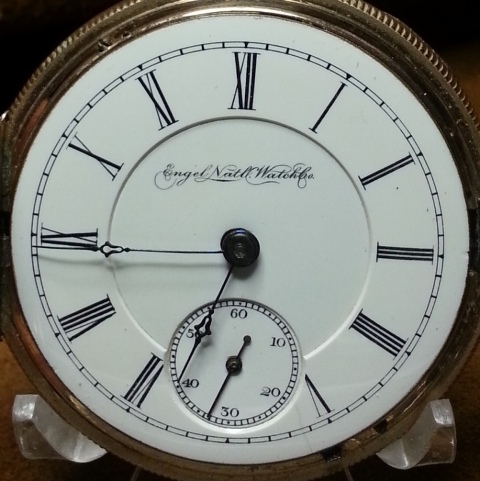 | |||
| IHC Member 1736 |
1894 Illinois 18S grade 65S movement serial number 1227502 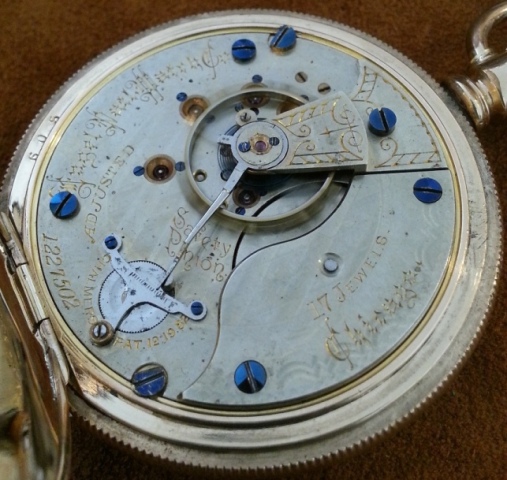 | |||
| IHC Member 1736 |
1915 Illinois 21J Sangamo Special correct dial - Source States: Double sunk glass enamel Arabic numeral dial  | |||
| IHC Member 1736 |
1915 Illinois 21J Sangamo Special movement serial number 2790456 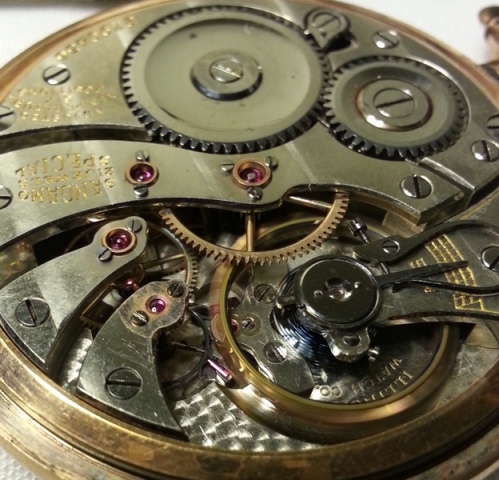 | |||
| IHC Member 1736 |
1927 J. Englel & Co. Baltimore Thirtieth Anniversary catalog 6 Position 60 Hour Sangamo Special correct dial 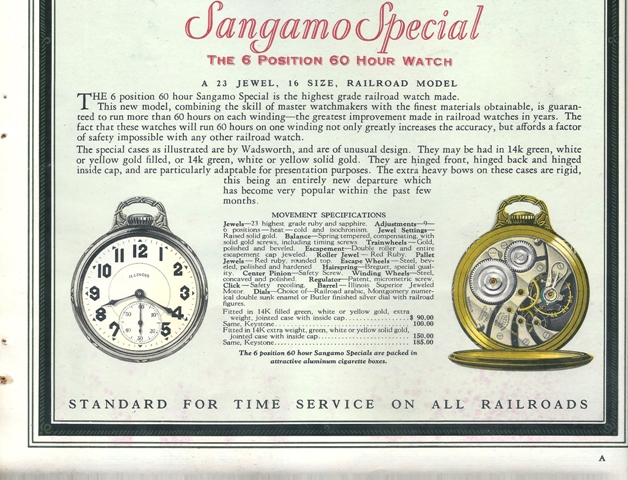 | |||
| IHC Member 1736 |
1927 J. Englel & Co. Baltimore Thirtieth Anniversary catalog 9 adjustment 6 position 60 hour Illinois Bunn Special correct dial 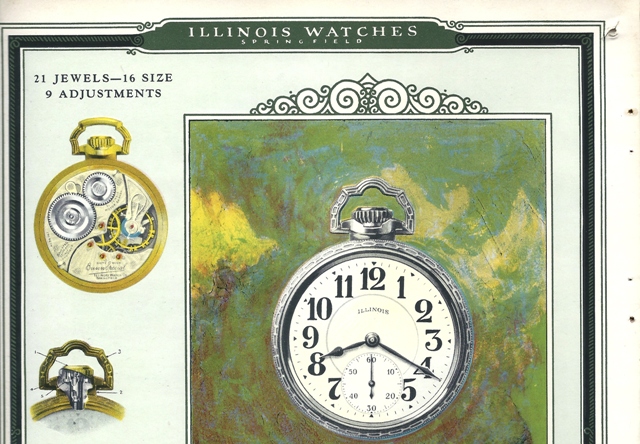 | |||
| IHC Member 1736 |
Lower half 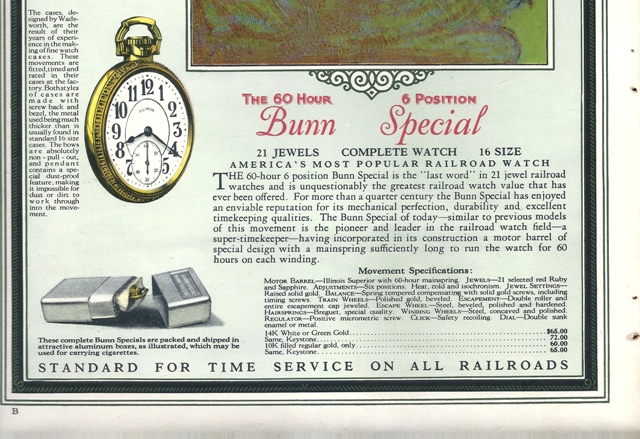 | |||
| IHC Member 1736 |
movement serial number 4319257 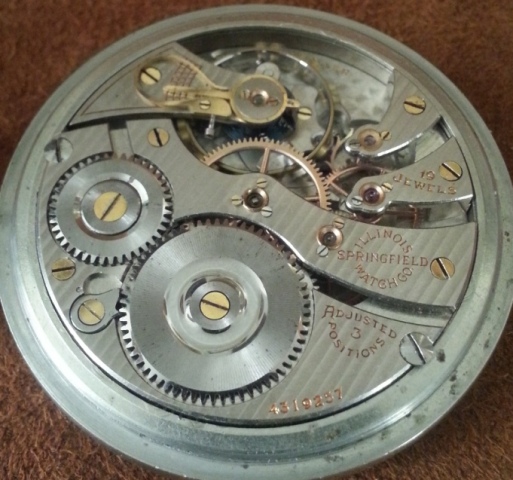 | |||
| IHC Member 1736 |
1903 Illinois Getty Model 5 Grade 176 correct dial - Source States: Double sunk glass enamel dial  | |||
| IHC Member 1736 |
movement serial number 1678679 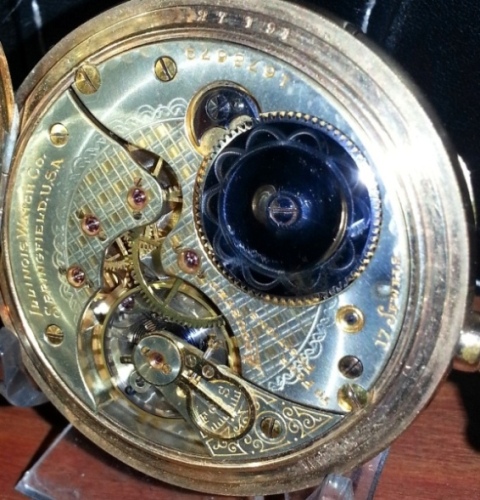 | |||
| IHC Member 1736 |
Illinois 4 foot dial - These dials were released in the transition era from model 5 Getty to model 6 movements. The extra foot could be cut to fit either the model 5 or the model 6 movement. This one is cut to fit a Getty model 5. 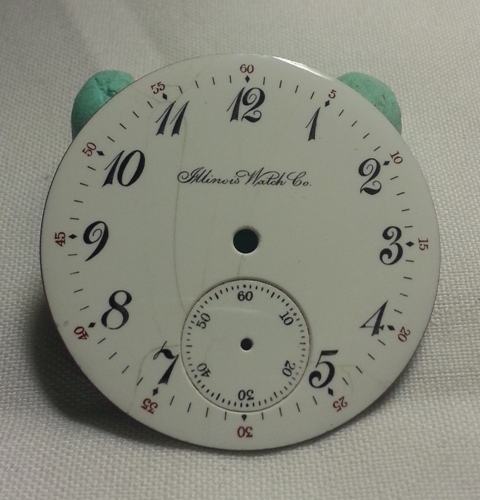 | |||
| IHC Member 1736 |
back side 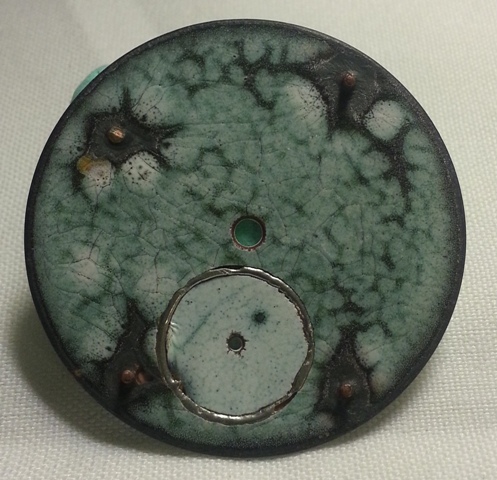 | |||
| IHC Member 1736 |
1920 18S 17J adj3p grade 89 Illinois correct dial - Source states: Double sunk glass or hard enamel dial marked "Illinois Watch Co" 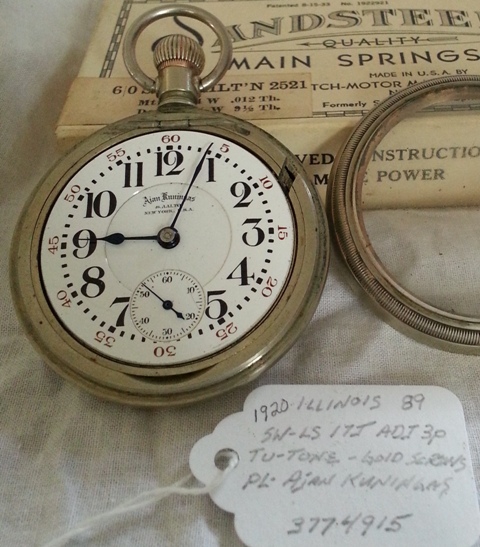 | |||
| IHC Member 1736 |
Movement serial number 3774915 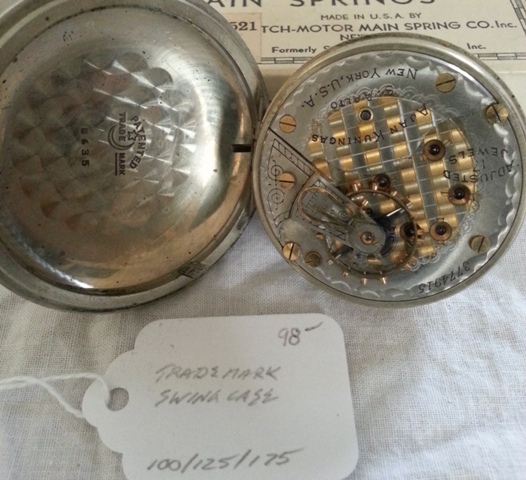 | |||
| IHC Member 1736 |
1920 16S 17J adj Illinois grade 305 correct dial - source states: Double sunk glass enamel dial This 305 has the much larger seconds bit... it comes almost all the way to the center hole. 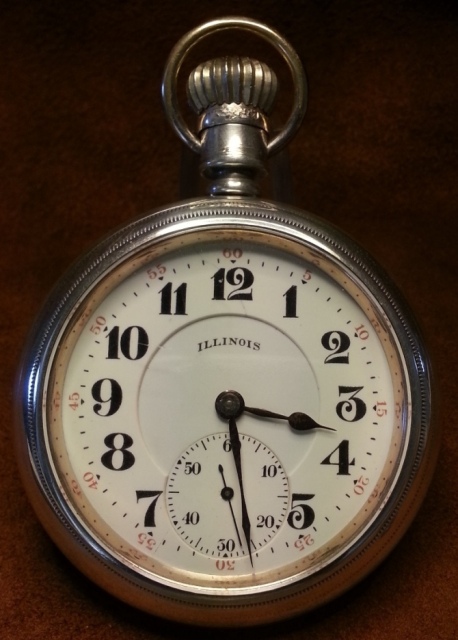 | |||
| IHC Member 1736 |
Movement serial number 3757289  | |||
| IHC Member 1736 |
1922 Illinois Bunn Special model 9 21J adj6p correct dial - source states: Double sunk glass enamel or sunk seconds or silvered metal bold arabic numeral dial 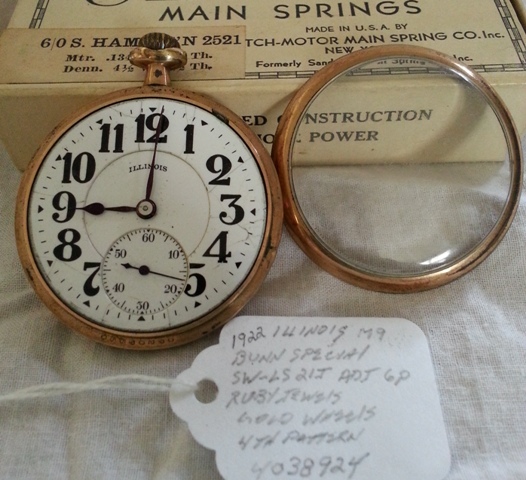 | |||
| IHC Member 1736 |
movement serial number 4038924 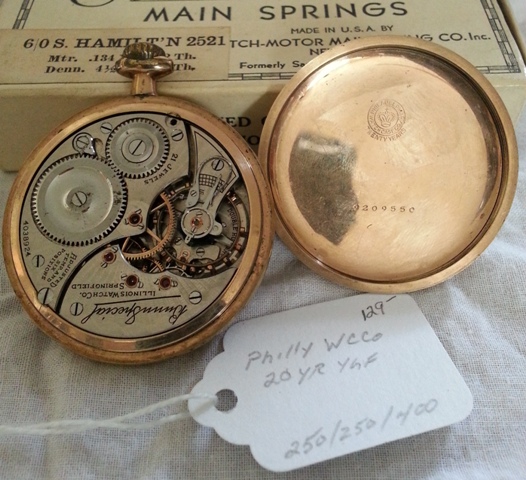 | |||
| IHC Member 1736 |
1902 Illinois model 5 1 of 1300 grade 183 16J unadjusted, mixed hands, correct dial - source states: Double sunk glass enamel dial | |||
| IHC Member 1736 |
movement serial number 1611397 | |||
| IHC Member 1736 |
If you like the idea of this project, please add examples of your own. This is all about getting it right. You are not going to hurt my feelings if I've made a mistake above that needs to be corrected... or if you have additional information I can add to certain post to improve the information. Probably best to email me direct rather than clutter the entries below with corrections... but either method is perfectly fine. If we put the production date, Illinois, model and grade, plus the words "correct dial"... it will pop on any search for a correct dial with matching parameters. My hope is that with enough entries... we can gather enough examples to define where the cut offs are for a few things like: - red dot dial start and stop - various examples of "white enamel dials" and what models they are found on - dial options prior to the red dot dials - script/curved/straight line Illinois signatures - Arrows in/Arrows out/half circles/diamonds... Some of these questions have already been answered in other post... I just need a bit of time to go find them... Things like... the straight line signature changed to a curved signature in either 1914 or 1917, depending on which post you read and believe. I'm going to reserve the next entry space for consolidated notes that I'm able to glean from other post and comments further down in this post as it gains entries. Happy Hunting, Paul-T | |||
| IHC Member 1736 |
Reserved for collective notes Link to several RR dial examples: https://ihc185.infopop.cc/eve/f...3967177/m/1333931587 This discussion figures the signature changed from straight line to curved in 1917: https://ihc185.infopop.cc/eve/f...6047761/m/9666069502 | |||
| IHC Life Member |
Paul, I commend your effort. Make sure that your "correct dial" designations don't imply that the dial shown is the only correct one. That generally isn't the case. | |||
| IHC Member 1736 |
Ethan brings up an excellent point. During the pre-factory cased years... movements were purchased at or from a distributor. A jeweler, mercantile, your local inspector... Case, dial and hand combinations could be chosen right there at the counter. Most conform to generally accepted conventions. I'm hoping that some of these will become more apparent as known examples continue to be added to this thread. Things like, thin spade hands go with small Arabic numerals and bold spade hands go with bold Arabic numerals. The long thin spades with a distinct waist are correct for early 18S Roman Numeral dials... I'm hoping Buster and some others will offer up some examples of correct Gothic dial and hand combinations to help us isolate the years and models those are correct to. The dial, hand and movement combinations demonstrated in the Blue Hampden book have been assimilated from known examples believed to be correct. These are not hard and fast rules... but more a process of data stacking. You can email photos of watches or scans of catalogs to me for entry if you don't want to spend the time cropping them and building the narratives. | |||
| IHC Member 1736 |
1902 Illinois Sangamo correct dial - source states: Double-sunk glass enamel Gothic style Arabic numeral dial marked "Illinois Watch Co." in Old English | |||
| IHC Member 1736 |
Movement serial number 1451890. 1 of 1,000 total in grade. Model 4 Sangamo Getty 21RJ-HN4L-T6PI-RRG Ruby jewels in gold settings, gold balance screws, polished gold train wheels and rounded spokes, patent regulator. Gold inlaid ribbon (second) pattern, damaskeened nickle black filled engraving. This watch is one of a few "pink" versions within this grade. | |||
| IHC Member 1736 |
1920 Great Northern Special, red dot, large seconds, curved signature. Source simply says: Double sunk glass enamel dial https://ihc185.infopop.cc/eve/f...853936487#3853936487 | |||
| IHC Member 1736 |
Movement | |||
| IHC Member 1736 |
18S Illinois Bunn - Bunn Special correct dial and movement combinations. Compliments of the late Ed Parsons https://ihc185.infopop.cc/eve/f...1029912/m/4753958877 | |||
| Powered by Social Strata |
| Your request is being processed... |
|
Welcome Aboard IHC185™  Internet Horology Club 185
Internet Horology Club 185  IHC185™ Discussion Site Main Page
IHC185™ Discussion Site Main Page  Open to the World RESEARCH FORUMS
Open to the World RESEARCH FORUMS  Illinois Watch Company Research Forum
Illinois Watch Company Research Forum  Illinois Dial + Movement combinations
Illinois Dial + Movement combinations
 Internet Horology Club 185
Internet Horology Club 185  IHC185™ Discussion Site Main Page
IHC185™ Discussion Site Main Page  Open to the World RESEARCH FORUMS
Open to the World RESEARCH FORUMS  Illinois Watch Company Research Forum
Illinois Watch Company Research Forum  Illinois Dial + Movement combinations
Illinois Dial + Movement combinations©2002-2025 Internet Horology Club 185™ - Lindell V. Riddle President - All Rights Reserved Worldwide


